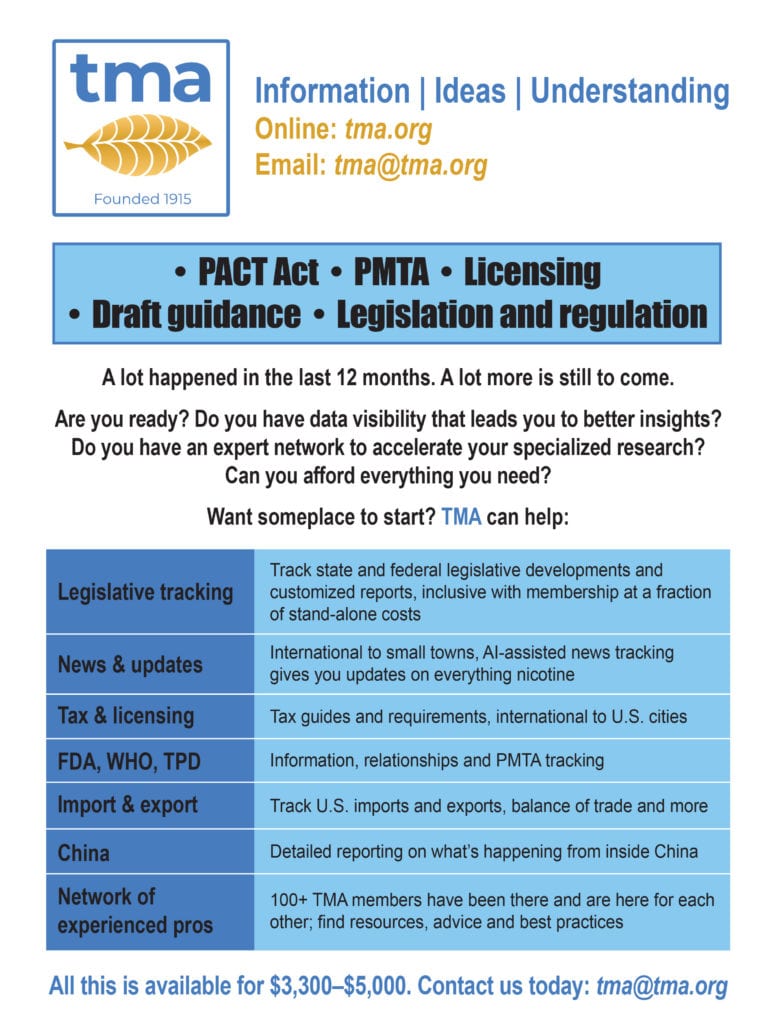
A large study conducted by the TPA shows e-cigarettes control youth smoking.
By Maria Verven
An extensive, state-by-state analysis conducted by the Taxpayers Protection Alliance (TPA) proves e-cigarettes are more effective in controlling youth smoking than tobacco control programs started after the Master Settlement Agreement (MSA).
“Tobacco & Vaping 101: 50 State Analysis,” authored by Lindsey Stroud, uses data from the Centers for Disease Control and Prevention (CDC) to argue the benefits of vaping, especially when it comes to teen usage. Ironically, this same data had been used to create public hysteria over vaping rates, especially among youth.
“As lawmakers across the country seek to reduce youth tobacco and vapor product use, many have introduced and passed legislation that regulates, taxes and in some cases prohibits the sale of products that actually help reduce tobacco use,” Stroud said.
Stroud said she’s been using the findings in state legislative testimony this year. “I’ve received positive feedback from pro-vaping and tobacco groups but have not heard much back from the anti-groups,” she said. “They may be surprised to see that I used the same data they do to argue the benefits of vaping,” she said, adding that she’s determined to make this information publicly available and accessible.
Stroud said she hopes other researchers and industry followers will use the report’s state-by-state information on adult and youth use of tobacco and vapor products in future articles and reports.
Of particular interest is the effectiveness—or lack thereof—of tobacco settlement payments, taxes and vapor products on reducing combustible cigarette use.
While all 50 states and Washington, D.C. saw a decrease in the percent of smokers, some states actually saw an increase in the number of smokers, due to an overall increase in the state’s population. Stroud’s analysis took into account both the percent difference and population change in examining adult and youth vapor and tobacco rates.
The analysis of cigarette tax revenues between 2000 and 2019 found that while cigarette tax hikes helped increase revenues in the short-term, these increases didn’t contribute to the decline in smoking rates.
It also shows that most states drastically underfunded programs for tobacco cessation services, education and prevention after collecting cigarette tax revenue and tobacco settlement monies over the past 19 years.
Vapor products tied to decrease in youth smoking
Of greatest importance is the analysis on the reduction in youth use of combustible cigarettes—which is at an all-time low. The report also examines youth vapor rates, specifying whether they ever tried an e-cigarette or are truly current or daily users.
Here’s where the data got really interesting. Stroud compared the smoking rates among 18-year-olds to 24-year-olds in the 10 years after the MSA with the smoking rates in the 10 years after e-cigarettes appeared on the market.

Lo and behold, there were greater decreases in smoking rates in the 10 years after the emergence of e-cigarettes when compared to the 10 years after tobacco settlement lawsuits.
And in the four states where smoking rates actually increased after e-cigarettes came on the market, policymakers had increased scrutiny and restrictions on e-cigarettes due to the perceived youth vaping “epidemic.” Coincidence? Stroud doesn’t think so.
“Addressing youth use of any age-restricted product is laudable, but it should not come at the expense of adult users of such products,” Stroud wrote in Politics, adding that bans, arduous regulations and/or unfair taxation threaten adult access to e-cigarettes and other tobacco harm reduction products.
“Completely disregarding that youth smoking rates are at all-time lows, officials often propose ‘solutions’ that fail to address the real reason why youth use e-cigarettes,” Stroud said.
States with higher rates of youth smoking have higher rates of youth vaping. Stroud said that the data clearly indicate that youth use e-cigarettes because friends and family members use them.
When asked about the “primary reason” for using e-cigarette products (among current users, only 10 percent of respondents from many states answered it was due to “flavors” while 17 percent cited “friends and family” and 51 percent cited “other.”
Vapor Voice caught up with Lindsey Stroud to learn more about this groundbreaking report and how this plethora of tobacco and vaping data can be used to inform future policymaking.
Vapor Voice: How was all this data collected? How long did it take?
Stroud: The idea was to provide policymakers with a plethora of tobacco-related data in a simplified manner.
We compiled the data manually by inputting data from the Centers for Disease Control and Prevention’s Behavior Risk Factor Surveillance System (BRFSS) between 1995 and 2019.
While state-specific BRFSS data included detailed demographic information such as age, gender, race, education level, income and smoking status, it wasn’t easy finding that data for the U.S. as a whole. So I started going through individual state data and putting together state-specific spreadsheets on cigarette use.
In addition, I examined annual state cigarette tax receipts, annual state tobacco control funding, cigarette tax increases and youth tobacco and vapor product use, which came from the CDC’s Youth Risk Behavior Survey.
It’s important to note that the Campaign for Tobacco-Free Kids also uses this same BRFSS data. However, while Tobacco-Free Kids only shows smoking rates and the cost of smoking in each state, we pulled various data items to tell a more complete, insightful picture.
What surprised you the most about this project?
I was amazed that my hypothesis—that e-cigarettes were more effective than the MSA in reducing smoking rates among young adults—actually held true. It was really eye-opening.
It’s still pretty amazing that 45 states and D.C. saw greater decreases in smoking rates among 18[-year-old] to 24-year-old adults in the 10 years after e-cigarettes emerged on the market than in the 10 years after the tobacco companies started shelling out millions that states were supposed to use on smoking cessation programs.
In the outlier states, smoking rates were at their lowest levels ever until 2018—the same year the surgeon general declared a “youth vaping epidemic.” Tragically, that’s when smoking rates began to increase.
Why did you feel this data was needed?
I really wanted to show policymakers data that compared youth vaping to youth smoking rates, which were way higher in the 1990s, especially compared to today’s youth vaping rates.
In all states, cigarette tax increases led to immediate increases in revenue in the short term, but these have all fallen as less adults smoke cigarettes.
I also wanted to call attention to the lack of state funding for tobacco control programs, despite the fact that states receive millions if not billions of dollars annually from tobacco monies such as excise taxes and tobacco settlement payments.
As far as I know, this is one if not the first analysis of the BRFSS data to include graphs—which clearly show the reduction in smoking rates among young adults as well as how little funding is spent on tobacco control.
Finally, I wanted to prove my hypothesis that vaping can take much of the credit for the reduction in both adult and youth smoking rates.
The analysis can be found at: www.protectingtaxpayers.org/harm-reduction/tobacco-vaping-101-50-state-analysis/
The original “Vaping Vamp,” Maria Verven owns Verve Communications, a PR and marketing firm specializing in the vapor industry.


